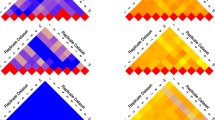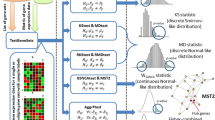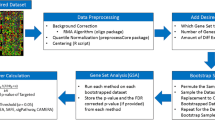Abstract
The analysis of gene sets (in a form of functionally related genes or pathways) has become the method of choice for extracting the strongest signals from omics data. The motivation behind using gene sets instead of individual genes is two-fold. First, this approach incorporates pre-existing biological knowledge into the analysis and facilitates the interpretation of experimental results. Second, it employs a statistical hypotheses testing framework. Here, we briefly review main Gene Set Analysis (GSA) approaches for testing differential expression of gene sets and several GSA approaches for testing statistical hypotheses beyond differential expression that allow extracting additional biological information from the data. We distinguish three major types of GSA approaches testing: (1) differential expression (DE), (2) differential variability (DV), and (3) differential co-expression (DC) of gene sets between two phenotypes. We also present comparative power analysis and Type I error rates for different approaches in each major type of GSA on simulated data. Our evaluation presents a concise guideline for selecting GSA approaches best performing under particular experimental settings. The value of the three major types of GSA approaches is illustrated with real data example. While being applied to the same data set, major types of GSA approaches result in complementary biological information.
Access this chapter
Tax calculation will be finalised at checkout
Purchases are for personal use only
Similar content being viewed by others
References
Mootha VK et al (2003) PGC-1alpha-responsive genes involved in oxidative phosphorylation are coordinately downregulated in human diabetes. Nat Genet 34(3):267–273
Bar HY, Booth JG, Wells MT ((2012)) A mixture-model approach for parallel testing for unequal variances. Stat Appl Genet Mol Biol 11(1.) p. Article 8
Ho JW et al (2008) Differential variability analysis of gene expression and its application to human diseases. Bioinformatics 24(13):i390–i398
Hulse AM, Cai JJ (2013) Genetic variants contribute to gene expression variability in humans. Genetics 193(1):95–108
Mar JC et al (2011) Variance of gene expression identifies altered network constraints in neurological disease. PLoS Genet 7(8):e1002207
Xu Z et al (2011) Antisense expression increases gene expression variability and locus interdependency. Mol Syst Biol 7:468
Bravo HC et al (2012) Gene expression anti-profiles as a basis for accurate universal cancer signatures. BMC Bioinform 13:272
Dinalankara W, Bravo HC (2015) Gene expression signatures based on variability can robustly predict tumor progression and prognosis. Cancer Informat 14:71–81
Friedman JH, Rafsky LC (1979) Multivariate generalizations of the Wald-Wolfowitz and Smirnov two-sample tests. Ann Stat 7(4):697–717
Rahmatallah Y, Emmert-Streib F, Glazko G (2012) Gene set analysis for self-contained tests: complex null and specific alternative hypotheses. Bioinformatics 28(23):3073–3080
Afsari B, Geman D, Fertig EJ (2014) Learning dysregulated pathways in cancers from differential variability analysis. Cancer Informat 13(Suppl 5):61–67
Fisher R (1932) Statistical methods for research workers. Oliver and Boyd, Edinburg
Stadler N, Mukherjee S (2015) Multivariate gene-set testing based on graphical models. Biostatistics 16(1):47–59
Friedman J, Hastie T, Tibshirani R (2008) Sparse inverse covariance estimation with the graphical lasso. Biostatistics 9(3):432–441
Meinshausen N, Bühlmann P (2006) High-dimensional graphs and variable selection with the lasso. Ann Stat 34(3):1436–1462
Schafer J, Strimmer K (2005) A shrinkage approach to large-scale covariance matrix estimation and implications for functional genomics. Stat Appl Genet Mol Biol 4(1):Article 32
Choi Y, Kendziorski C (2009) Statistical methods for gene set co-expression analysis. Bioinformatics 25(21):2780–2786
Rahmatallah Y, Emmert-Streib F, Glazko G (2014) Gene Sets Net Correlations Analysis (GSNCA): a multivariate differential coexpression test for gene sets. Bioinformatics 30(3):360–368
Santos Sde S et al (2015) CoGA: an R package to identify differentially co-expressed gene sets by analyzing the graph spectra. PLoS One 10(8):e0135831
Takahashi DY et al (2012) Discriminating different classes of biological networks by analyzing the graphs spectra distribution. PLoS One 7(12):e49949
Goeman JJ, Buhlmann P (2007) Analyzing gene expression data in terms of gene sets: methodological issues. Bioinformatics 23(8):980–987
Tian L et al (2005) Discovering statistically significant pathways in expression profiling studies. Proc Natl Acad Sci U S A 102(38):13544–13549
Ackermann M, Strimmer K (2009) A general modular framework for gene set enrichment analysis. BMC Bioinform 10(1):47
Rahmatallah Y, Emmert-Streib F, Glazko G (2014) Comparative evaluation of gene set analysis approaches for RNA-Seq data. BMC Bioinform 15(1):397
Montaner D et al (2009) Gene set internal coherence in the context of functional profiling. BMC Genomics 10:197
Gatti DM et al (2010) Heading down the wrong pathway: on the influence of correlation within gene sets. BMC Genomics 11:574
Tripathi S, Emmert-Streib F (2012) Assessment method for a power analysis to identify differentially expressed pathways. PLoS One 7(5):e37510
Glazko GV, Emmert-Streib F (2009) Unite and conquer: univariate and multivariate approaches for finding differentially expressed gene sets. Bioinformatics 25(18):2348–2354
Wang X et al (2011) Linear combination test for hierarchical gene set analysis. Stat Appl Genet Mol Biol 10(1.) Article 13
Hanzelmann S, Castelo R, Guinney J (2013) GSVA: gene set variation analysis for microarray and RNA-seq data. BMC Bioinform 14:7
Khatri P, Sirota M, Butte AJ (2012) Ten years of pathway analysis: current approaches and outstanding challenges. PLoS Comput Biol 8(2):e1002375
Maciejewski H (2014) Gene set analysis methods: statistical models and methodological differences. Brief Bioinform 15(4):504–518
Nam D, Kim SY (2008) Gene-set approach for expression pattern analysis. Brief Bioinform 9(3):189–197
Tamayo P et al (2012) The limitations of simple gene set enrichment analysis assuming gene independence. Stat Methods Med Res 25(1):472–487
Tarca AL, Bhatti G, Romero R (2013) A comparison of gene set analysis methods in terms of sensitivity, prioritization and specificity. PLoS One 8(11):e79217
Tripathi S, Glazko GV, Emmert-Streib F (2013) Ensuring the statistical soundness of competitive gene set approaches: gene filtering and genome-scale coverage are essential. Nucleic Acids Res 41(7):e82
Dinu I et al (2007) Improving gene set analysis of microarray data by SAM-GS. BMC Bioinform 8:242
Subramanian A et al (2005) Gene set enrichment analysis: a knowledge-based approach for interpreting genome-wide expression profiles. Proc Natl Acad Sci U S A 102(43):15545–15550
Barbie DA et al (2009) Systematic RNA interference reveals that oncogenic KRAS-driven cancers require TBK1. Nature 462(7269):108–112
Fridley BL, Jenkins GD, Biernacka JM (2010) Self-contained gene-set analysis of expression data: an evaluation of existing and novel methods. PLoS One 5(9)
Stouffer S, DeVinney L, Suchmen E (1949) The American soldier: adjustment during army life, vol 1. Princeton University Press, Princeton, NJ
Taylor J, Tibshirani R (2006) A tail strength measure for assessing the overall univariate significance in a dataset. Biostatistics 7(2):167–181
Robinson MD, McCarthy DJ, Smyth GK (2010) edgeR: a Bioconductor package for differential expression analysis of digital gene expression data. Bioinformatics 26(1):139–140
Anders S, Huber W (2010) Differential expression analysis for sequence count data. Genome Biol 11(10):R106
Smyth G (2005) Limma: linear models for microarray data. In: Smyth G, Gentleman R, Carey V, Dudoit S, Irizarry R, Huber W (eds) Bioinformatics and computational biology solutions using r and bioconductor. Springer, New York, pp 397–420
Law CW et al (2014) Voom: precision weights unlock linear model analysis tools for RNA-seq read counts. Genome Biol 15(2):R29
Rahmatallah Y, Emmert-Streib F, Glazko G (2016) Gene set analysis approaches for RNA-seq data: performance evaluation and application guideline. Brief Bioinform 17(3):393–407
Tusher VG, Tibshirani R, Chu G (2001) Significance analysis of microarrays applied to the ionizing radiation response. Proc Natl Acad Sci U S A 98(9):5116–5121
Baldi P, Long AD (2001) A Bayesian framework for the analysis of microarray expression data: regularized t -test and statistical inferences of gene changes. Bioinformatics 17(6):509–519
Smyth GK (2004) Linear models and empirical Bayes methods for assessing differential expression in microarray experiments. Stat Appl Genet Mol Biol 3:3
Dinu I et al (2009) Gene-set analysis and reduction. Brief Bioinform 10(1):24–34
Liu Q et al (2007) Comparative evaluation of gene-set analysis methods. BMC Bioinform 8:431
Baringhaus L, Franz C (2004) On a new multivariate two-sample test. J Multivar Anal 88:190–206
Klebanov L et al (2007) A multivariate extension of the gene set enrichment analysis. J Bioinforma Comput Biol 5(5):1139–1153
Wu D et al (2010) ROAST: rotation gene set tests for complex microarray experiments. Bioinformatics 26(17):2176–2182
Damian D, Gorfine M (2004) Statistical concerns about the GSEA procedure. Nat Genet 36(7):663. author reply 663
Ritchie ME et al (2015) limma powers differential expression analyses for RNA-sequencing and microarray studies. Nucleic Acids Res 43(7):e47
Pickrell JK et al (2010) Understanding mechanisms underlying human gene expression variation with RNA sequencing. Nature 464(7289):768–772
Olivier M et al (2002) The IARC TP53 database: new online mutation analysis and recommendations to users. Hum Mutat 19(6):607–614
Liberzon A et al (2011) Molecular signatures database (MSigDB) 3.0. Bioinformatics 27(12):1739–1740
Wu D, Smyth GK (2012) Camera: a competitive gene set test accounting for inter-gene correlation. Nucleic Acids Res 40(17):e133
Bandres E et al (2005) Gene expression profile induced by BCNU in human glioma cell lines with differential MGMT expression. J Neuro-Oncol 73(3):189–198
Ongusaha PP et al (2003) BRCA1 shifts p53-mediated cellular outcomes towards irreversible growth arrest. Oncogene 22(24):3749–3758
Acknowledgments
We would like to thank Bárbara Macías Solís for proof reading of the manuscript. Support has been provided in part by the Arkansas INBRE program, with grants from the National Center for Research Resources (P20RR016460) and the National Institute of General Medical Sciences (P20 GM103429) from the National Institutes of Health. Large-scale computer simulations were implemented using the High Performance Computing (HPC) resources at the UALR Computational Research Center supported by the following grants: National Science Foundation grants CRI CNS-0855248, EPS-0701890, MRI CNS-0619069 and OISE-0729792.
Author information
Authors and Affiliations
Corresponding author
Editor information
Editors and Affiliations
Rights and permissions
Copyright information
© 2017 Springer Science+Business Media LLC
About this protocol
Cite this protocol
Glazko, G., Rahmatallah, Y., Zybailov, B., Emmert-Streib, F. (2017). Extracting the Strongest Signals from Omics Data: Differentially Expressed Pathways and Beyond. In: Tatarinova, T., Nikolsky, Y. (eds) Biological Networks and Pathway Analysis. Methods in Molecular Biology, vol 1613. Humana Press, New York, NY. https://doi.org/10.1007/978-1-4939-7027-8_7
Download citation
DOI: https://doi.org/10.1007/978-1-4939-7027-8_7
Published:
Publisher Name: Humana Press, New York, NY
Print ISBN: 978-1-4939-7025-4
Online ISBN: 978-1-4939-7027-8
eBook Packages: Springer Protocols




